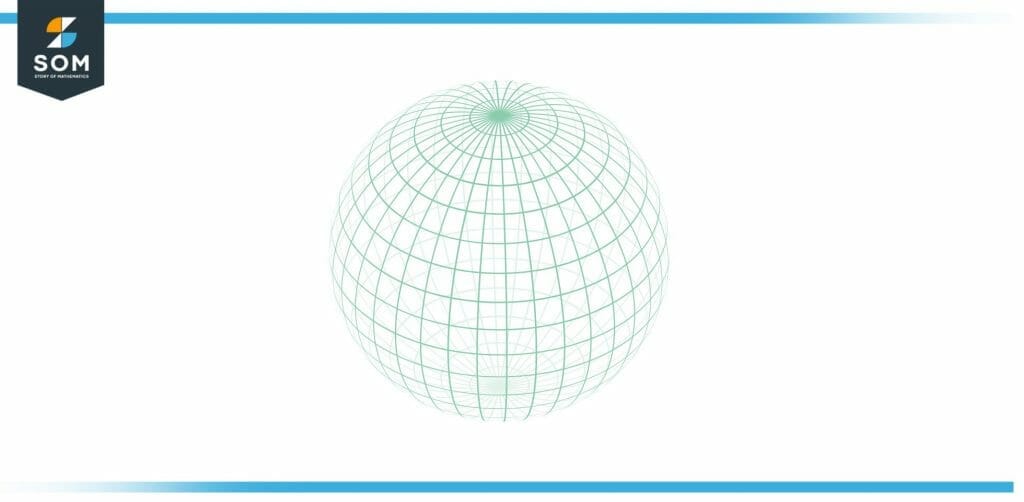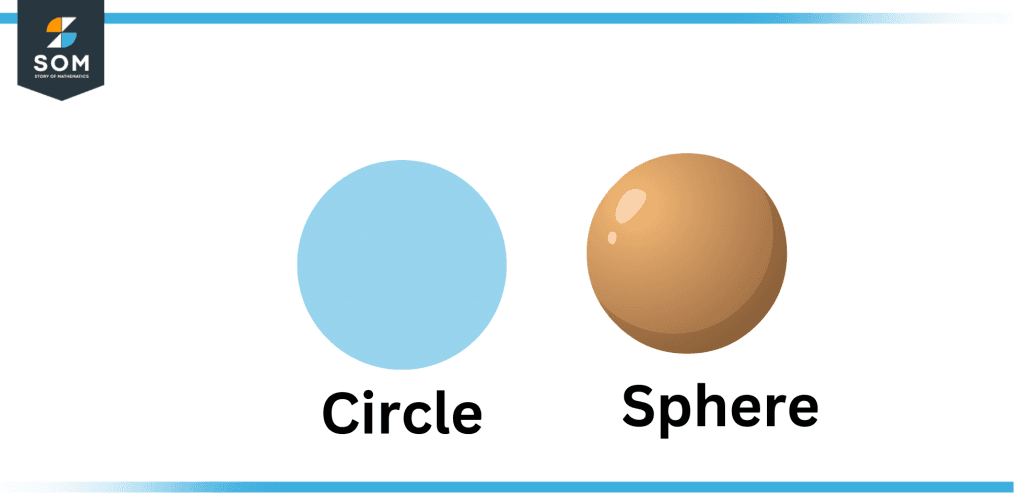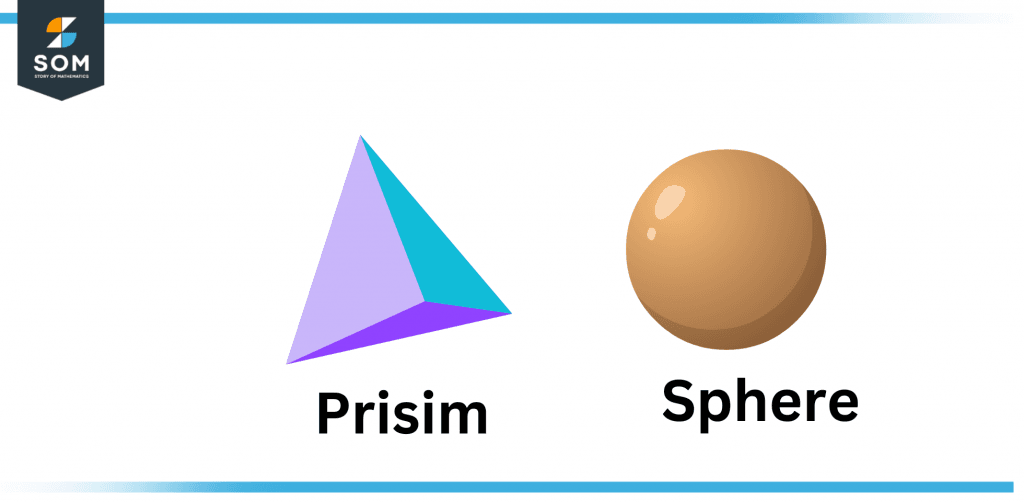JUMP TO TOPIC
Sphere|Definition & Meaning
Definition
A sphere is the 3D counterpart of a circle and looks like a round ball. It has no edges, vertices, or face (just a curved surface). Like a circle in 2D, every point on the sphere’s surface is equidistant from its center, meaning it is perfectly symmetrical. In fact, if you rotate the boundary of a flat circle around a fixed center in 3D, you trace the boundary of a sphere.
A round object that has three dimensions and has the shape of a sphere is called a sphere. Three axes define the sphere; these are the x-axis, the y-axis, and the z-axis. This is the most significant distinction between a sphere and a circle. A sphere, unlike other three-dimensional shapes, does not contain any edges or vertices.

Figure 1 – Sphere
Each point on the sphere’s surface is located at the same distance from the sphere’s center. Consequently, the distance from the center to the sphere’s surface is the same in every place along its circumference. This particular distance is referred to as the sphere’s “radius.” A ball, a globe, and even the planets themselves are all examples of spheres.
A sphere must be perfectly round to meet the definition of a spherical. This implies that the distance between a sphere’s exterior surface and center is constant. Because they show a special relationship between their surface area & volume, spheres are special in geometry.
The quantity of space required to round an object’s exterior surface completely is known as surface area. On the other hand, the amount of space a 3D object encompasses is known as its volume. Of all of the three-dimensional geometric shapes, the sphere’s surface area to volume ratio is the smallest.
This means that compared to other shapes with the same amount of surface area, it occupies more three-dimensional space.
A spheroid is a circular, three-dimensional object that is round but not exactly round (i.e., the distance between the surface and the center varies). Spheroids are significantly more frequent in nature than flawless spheres since they are difficult to create. Planets are one example, which frequently has their poles somewhat flattened. A hemisphere is a perfectly flat, divided sphere with a single, level surface.
The Geometry of a Sphere
A sphere has a shape that is round and doesn’t have any faces on its exterior. The sphere is indeed a geometrical solid that has three dimensions and a curved surface. A sphere, unlike several other solids such as a cube, cuboid, cone, or cylinder, does not contain any flat surfaces, vertices, or edges.
The Characteristics of a Sphere
The following list describes the essential characteristics of the sphere. These qualities are sometimes referred to as the characteristics of the sphere.
- A spherical object has symmetry all the way through.
- A sphere cannot be considered a polyhedron.
- The distance from the center to all points on the curved surface of the sphere is the same. A sphere doesn’t have a surface that is composed of centers.
- A sphere has a mean curvature that is constant.
- Both the width and the circumference of a sphere are always the same.
Equation of a Sphere
A sphere’s equation can be written in analytical geometry as follows, where r is indeed the radius, (x, y, z) is the location of all points, and (xo, yo, zo) is the sphere’s center.
(x – x0)2 + (y – y0)2 + (z – z0)2 = r2
Calculating the Area of a Sphere’s Surface
The total area that is covered by the surface of a sphere in a space that is three-dimensional is referred to as the sphere’s surface area. The formula for the surface area can be written as follows:
Surface Area SA = 4πr2 square units
In this equation, “r” represents the radius of the sphere. The Volume of a Spherical Object. The quantity of space that the three-dimensional object known as a sphere takes up is referred to as the volume of a sphere.
Volume of Sphere V = (4/3)πr3 cubic units
Differences Between Sphere and Circle
Two-dimensional or 2D shapes include circles. Three-dimensional or 3D shapes include spheres. The x-axis and the y-abxis serve as the two axes that constitute a circle. The x, y, and z axes are the three axes that define a sphere.
A circle’s circumference defines an area. The area’s formula is πr$^2$. On the contrary, the surface area that a sphere’s outer surface covers equal 4πr$^2$.
There isn’t any volume in a circle since it is 2D. A circle, therefore, only has some area. A circle is also completely flat with a curved boundary. On the other hand, a sphere has volume since it is 3D, and is not flat but globular with a continuous curved surface.

Figure 2 – Circle and sphere
What Distinguishes the Sphere From Other 3D Objects?
The sphere shape lacks a flat surface, vertex, or edge, in contrast to other three-dimensional objects like the cube, cone, and cylinder. Only a rolling surface is present.

Figure 3 – Prism and sphere
Numerical Example of Spheres
Example 1
Discover the sphere’s volume with a 10 cm diameter.
Solution
Given that:
Diameter = 10 cm
Radius = half of diameter = 5 cm
Since the volume of a sphere is:
V = (4/3)$\pi$r3
By putting values, we get:
V = 522 cubic units
Hence, the sphere volume is 522 cubic units.
Example 2
Discover the sphere’s volume with a 20 cm diameter.
Solution
Given that:
Diameter = 20 cm
Radius = half of diameter = 10 cm
We know that the volume of the sphere is:
V = (4/3)$\pi$r3
By putting values, we get:
V = (4/3) x 3.14 x 103
By simplifying, we get:
V = 4186 cubic units
Hence, the sphere volume is 4186 cubic units.
Example 3
Discover the sphere’s surface area with a 14 cm diameter.
Solution
Given that:
Diameter = 14 cm
Radius = half of diameter = 7 cm
The surface area of a sphere is:
surface area = 4$\pi$r2
By putting values and simplifying, we get:
surface area = 616 square centimeters
Hence, the sphere volume is 616 cm squared.
Example 4
Discover the sphere’s surface area with a 10 cm diameter.
Solution
Given that:
Diameter = 10 cm
Radius = half of diameter = 5 cm
The surface area of the sphere is given by:
surface area = 4$\pi$r2
By putting values and simplifying, we get:
surface area = 314 square centimeters
Hence, the sphere volume is 314 cm squared.
All mathematical drawings and images were created with GeoGebra.
